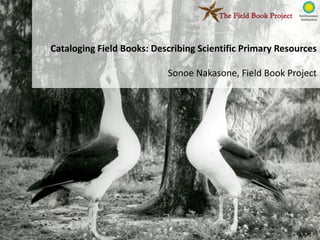
Cataloging Field Books: Describing Scientific Primary Resources
- 1. Cataloging Field Books: Describing Scientific Primary Resources Sonoe Nakasone, Field Book Project
- 2. The problem
- 3. The solution? National Museum of Smithsonian Institution Natural History + Archives Mission: to create a Field Book Registry, one online location for field book content everywhere.
- 4. What is a field book anyway? *Primary source material documenting scientific field work for biodiversity research.
- 5. Why do we care about field notes? • Original data • Locality and travel routes • Specimen details • Environmental or cultural context • Historical information and personal narrative
- 6. Why should you care? Rich history of “amateur” naturalists – John James Audubon – Robert Kennicott – WWII Soldier Collecting – Citizen scientists and enthusiasts Top: Plate CCCCXXXI, the Greater Flamingo, painted by John James Audubon for his folio The Birds of America (1827-1838). Bottom: Bailey, Charles. “On the structure, the occurrence in Lancashire, and the source of origin of Naias graminea, Del., var. Delilei, Magnus” London? 1884.
- 7. How are relevant field books found? SIA reference questions by scientific expedition 2001 to 2011 – 26% Material type / form – 26% Place (25% place and date) – 26% Collector – 22% Discipline / specimens
- 8. How are field books described? MARC 15.4% No answer 33.3% Dublin Core 10.3% EAD 12.8% Specify Local 2.6% Schema ICMS 17.9% 7.7%
- 9. Description methods for Field Book Project Collection Natural Collections Description (NCD) http://www.tdwg.org/activities/ncd/ Item Metadata Objects Description Schema (MODS) http://www.loc.gov/standards/mods/
- 10. Why MODS? • XML – Plain language – Platform independent • Simple, yet adaptable
- 12. Clarksburg Bloody Run Schellsburg Allegh
- 13. 112 111
- 14. 186 182 183 185 Salmon Pike
- 15. Item level description (not all elements shown) • Title • Form and Genre • Date • Geographic subjects • Accession number • Names of entities 26% Collection / form • Material type • Topical subjects 26% Place (25% place and date) • Location • Abstract 26% Collector • Physical Description 22% Discipline / specimens • Resource Type
- 16. 26% Material type / form Genre (AAT) Isness: Formats, material types, styles Field notes Sketches Maps Itineraries
- 17. 26% Place (25% place and date) Geographic subjects (TGN, GNIS) Places specimens were collected United States New York Pennsylvania District of Columbia Kentucky
- 18. Dates (ISO 8601 / W3CDTF) Date range (yyyy or yyyy-yyyy) Start date (YYYY or YYYYMMDD) End date (YYYY or YYYYMMDD) Qualifier (approximate, inferred, questionable)
- 19. 26% Collector Names as creators (VIAF) Persons, organizations, expeditions Creators, contributors Names as subjects (VIAF) Rafinesque, C. S. (Constantine Samuel), 1783-1840 = EACP20
- 20. 22% Discipline / specimens Topical subjects (LCSH) Aboutness: Topics, Disciplines, specimens Ichthyology Mollusks Botany Entomology Herpetology Mycology
- 21. Encoded Archival Context (EAC) • Creating archival authority records for persons, organizations, an d expeditions. • Social Networks and Archival Context (SNAC)
- 22. Future goals • Full online digital access • Crowdsourcing • Education and Outreach • Global participation
- 23. Acknowledgements Rusty Russell, Co-PI Anne Van Camp, Co-PI Collections & Informatics, Botany Director, SI Archives Carolyn Sheffield, Project Manager Sonoe Nakasone, Cataloging Coordinator Lesley Parilla, Cataloger and Graphics Designer Emily Hunter, Cataloger and Social Media Coordinator Kira Cherrix, Image and Video Digitization Specialist, SIA Ricc Ferrante, Director of Digital Services, SIA Tammy Peters, Supervisory Archivist, SIA Nora Lockshin, Paper Conservator, SIA Sarah Stauderman, Collections Care Manager, SIA Kirsten Tyree, Conservation Technician, SIA
- 24. Please Visit Our Website at http://mnh.si.edu/rc/fieldbooks/ Blog: http://nmnh.typepad.com/fieldbooks/ Flickr: http://tinyurl.com/fbpflickr Follow us on Twitter! @FieldBookProj Questions? Sonoe Nakasone nakasones@si.edu
Hinweis der Redaktion
- This is meant to be viewed as a presentation, so some of the slides have text and images layered. The layering makes sense in slideshow mode because they are animated to appear and disappear.
- How do you find related field books at multiple institutions? How do you find whether those books have the information you want?
- Conceptual models: OCLC and Biodiversity Heritage Library
- National survey. 39 responses. 33.3% did not answer the question what schema do you use to catalog field notes. During follow up interviews, we found most were confused about how to handle these materials.
- The following slides are examples from field notes to give you a sense of how we record information.
- Some of the basic elements used in our MODS records. Although all of these elements are important to access, I’d like to focus on some main access points, most of which use controlled vocabulary for consistency. As you can see, there is a strong correlation between these access points and the types of reference questions that frequently occur in the institution archives.
- Bottom row of funder logos.
- More product less process question: Use fosberg as example 100+ do you really want to go through all to find ___?Optional data elements—levels of descriptions options for time and resources
